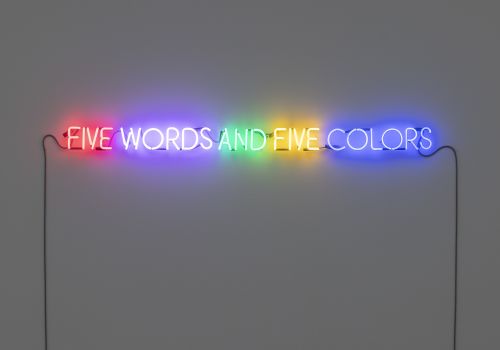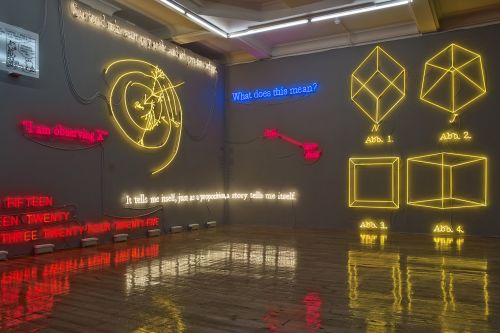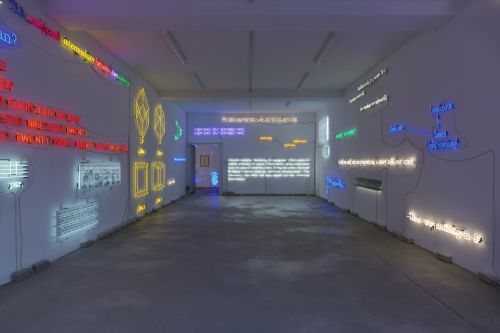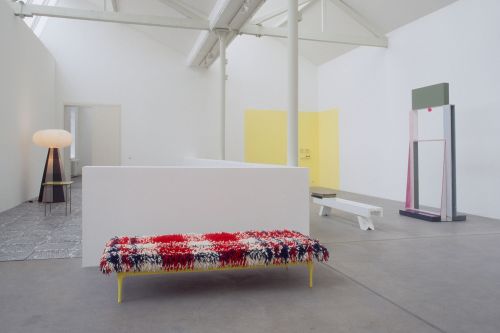Joseph Kosuth (*1945, Toledo, OH) lives and works in New York and Venice. Selected solo exhibitions include Kunstmuseum Stuttgart (2025), MAMM, Moscow (2015), Kunstmuseum Thurgau, Kartause Ittingen (2014), The Jewish Museum, New York (2012), Haus Konstruktiv, Zurich (2011), the ACCA – Australian Centre for Contemporary Art, Melbourne (2010), the Louvre, Paris (2009), the Schirn Kunsthalle, Frankfurt (2006), the Isabella Stewart Gardner Museum, Boston (2000), the Tokushima Modern Art Museum (1999), the Palais des Beaux Arts, Brussels (1990), the Sigmund Freud Museum, Vienna (1989) and the MoMA PS1, New York (1980). He has participated in Documenta V, VI, VII and IX (1972, 1977, 1982, 1992) and the Venice Biennale (2007, 1999, 1993, 1976). Awards include the Decoration of Honor in Gold for Services to the Republic of Austria (2003), the Chevalier de l’ordre des Arts et des Lettres from the French government (1993), the Menzione d’Onore at the Venice Biennale (1993) and the Brandeis Award (1990). In February 2001 he was awarded the Laurea Honoris Causa, a doctorate in Philosophy and Letters from the University of Bologna.
| Art Gallery of Ontario, Toronto |
| Art Institute Chicago, Chicago |
| Buffalo AKG Art Museum, New York |
| Castello di Rivoli, Turin |
| Centre Pompidou, Paris |
| Centro Andaluz de Arte Contemporáneo, Seville |
| Centrum Sztuki Współczesnej Zamek Ujazdowski, Warsaw |
| Civic Art Collection, San Francisco |
| Collection Lambert, Avignon |
| Collection of Berkeley Art Museum and Pacific Film Archive, Berkeley |
| Cornell Fine Arts Museum at Rollins College, Florida |
| Daimler Art Collection, Berlin |
| Des Moines Art Center, Iowa |
| Fer Collection, Ulm |
| Fine Arts Museums of San Francisco |
| Fondazione D’ARC, Rome |
| Fondo Ambiente Italiano, Italy |
| Fonds Regional d’Art Contemporain Rhone-Alpes, France |
| Fotomuseum Winterthur, Switzerland |
| Galleria Nazionale d’Arte Moderna, Rome |
| Harvard Art Museum, Cambridge |
| Haus Lange, Krefeld |
| Hirshhorn Museum and Sculpture Garden, D.C. |
| Honolulu Museum of Art, Honolulu |
| Institut für Auslandsbeziehungen, Stuttgart |
| Israel Museum, Jerusalem |
| Kaohsiung Museum of Fine Arts, Taiwan |
| Kunsthalle Mannheim, Germany |
| Kunstmuseum des Kantons Thurgau, Kartause |
| Kunstmuseum Stuttgart, Stuttgart |
| Kunstsammlung des Deutschen Bundestages, Berlin |
| Lombard Odier Private Bank, Geneva |
| Los Angeles County Museum of Art, Los Angeles |
| Louisiana Museum of Modern Art, Humlebaek |
| Magritte Museum – Royal Museum of Fine Arts of Belgium, Belgium |
| Malmš Konsthall, Sweden |
| Mildred Lane Kemper Art Museum at Washington University in St. Louis, St. Louis |
| Mumok, Vienna |
| Musée d’Art Contemporain Lyon, France |
| Musée du Louvre, Paris |
| Museo de Bellas Artes de Caracas, Venezuela |
| Museo del Novecento di Milano, Italy |
| Museo Nacional Centro de Arte Reina Sofía, Madrid |
| Museum Haus Konstruktiv, Zurich |
| Museum of Contemporary Art, Chicago |
| Museum of Contemporary Art, Sydney |
| Museum of Fine Arts, Boston |
| Museum of Modern and Contemporary Art, Bolzano |
| Museum Ludwig, Cologne |
| Museum van Hedendaagse Kunst Antwerpen, Antwerp |
| National Gallery of Art, Washington D.C. |
| National Gallery of Australia, Canberra |
| National Gallery of Canada, Ottawa |
| National Gallery of Victoria, Melbourne |
| National Museum of Contemporary Art, Athens |
| Ornellaia e Masseto, Bolgheri, Italy |
| Panza Collection, Mendrisio |
| Parliament of the Brussels-Capital Region, Brussels |
| Philadelphia Museum of Art, Philadelphia |
| Pomeranz Collection, Vienna |
| Saatchi Gallery, London |
| San Jose Museum of Art, San Jose |
| Serralves Foundation Museum of Contemporary Art, Porto, Portugal |
| S.M.A.K. Collection, Gent, Belgium |
| Staatsgalerie, Stuttgart |
| Tate, London |
| The Allen Memorial Art Museum at Oberlin College, Ohio |
| The Berardo Collection, Lisbon |
| The Centre of Modern and Contemporary Art of La Spezia, Italy |
| The Cleveland Museum of Art, Cleveland |
| The Collections at Villa Medici, Rome |
| The Ludwig Museum of Contemporary Art, Budapest |
| The Metropolitan Museum of Art, New York |
| The Museum of Contemporary Art, Los Angeles |
| The Museum of Modern Art, New York |
| The National Museum of Art, Architecture and Design, Oslo |
| The Solomon R. Guggenheim Museum, New York |
| The Stedelijk Museum, Amsterdam |
| The Whitney Museum of American Art, New York |
| Toledo Museum of Art, Toledo |
| Ulm Art Foundation, Ulm |
| Van Abbemuseum, Eindhoven |
| Walker Art Center, Minneapolis |
| Zentrum für Internationale Lichtkunst Unna, Unna, Germany |










































































